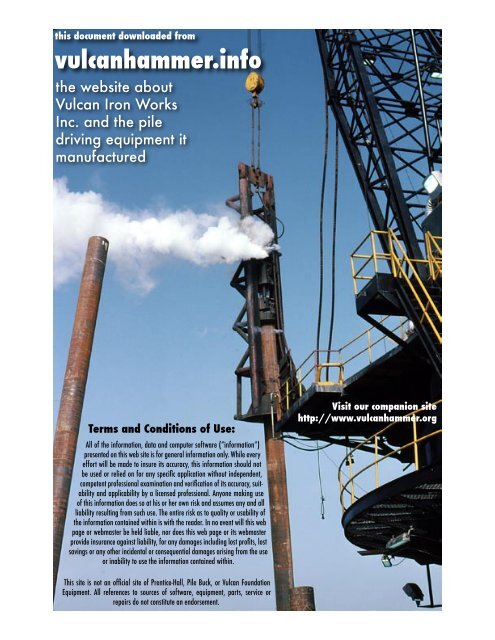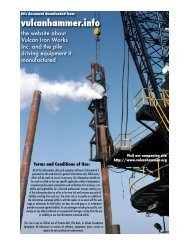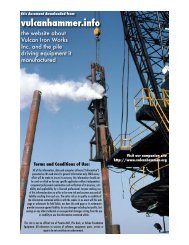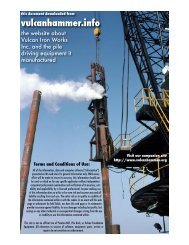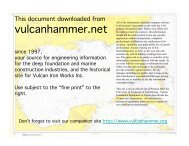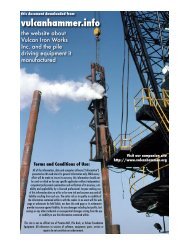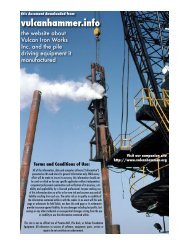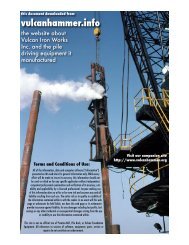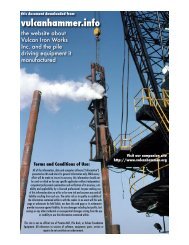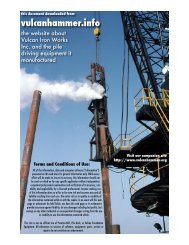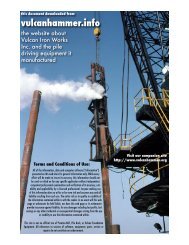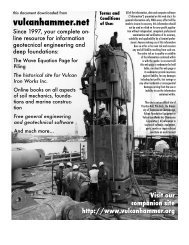Pile Drivability Analysis - vulcanhammer.info
Pile Drivability Analysis - vulcanhammer.info
Pile Drivability Analysis - vulcanhammer.info
Create successful ePaper yourself
Turn your PDF publications into a flip-book with our unique Google optimized e-Paper software.
Membership….SimplifiedFor CPC Branches in Western Ontario RegionTable of ContentsMembership Checklist ..................................................................................................... 1About CPC membership .................................................................................................. 2Types of membership .................................................................................................. 2When can we start accepting memberships? ............................................................... 3A bit about Insurance ................................................................................................... 3Accepting CPC membership application forms ................................................................ 4Using the Summary of CPC Memberships Submitted .................................................. 7About CPC Associate Membership ................................................................................. 9About OEF membership ................................................................................................ 10OEF membership options .......................................................................................... 10Options for applying for OEF membership in order of preference .............................. 11Accepting OEF application forms .................................................................................. 12Checking OEF Application forms ............................................................................... 12Completing the OEF Confirmation of Membership Form ............................................ 14What payments are required? ....................................................................................... 16Submitting the application forms ................................................................................... 17Where do I mail the OEF Membership Applications? ................................................. 17Where do I mail the CPC Membership Applications? ................................................. 17Receiving confirmation of OEF membership ................................................................. 18Frequently Asked Questions ......................................................................................... 19Contacts ........................................................................................................................ 19Canadian Pony Club, Western Ontario RegionOctober 20111
L' In the 19501s, E. A. L. ~mith(~)(~)(~) developed and proposed a step-by-step finite difference solution to the differential equation thatcould be used with the high-speed digital computers emerging at that time.This solution and the rapidly increasing availability of high-speed digitalcomputers has led to the widespread use of the one-dimensional wave equationto analyze practical pile driving problems (6) (7)For a wave equation analysis, the pile driver ram, cushion, drivecap, pile and soil shown on the left side of Fig. 23-2 are modeled as shown onthe right side.The ram is frequently represented by a concentrated mass, thecushion by a weightless spring, and the dr-ive cap by a second point mass.Thepile is divided into segments, each represented by a point mass equal to themass of the segment and by a spring of stiffness equal to the stiffness of thesegment .Soil resistance is modeled by elastic-plastic springs and dashpots actingin parallel with the pile stiffness springs.The location and ultimate resistanceof each of the soil springs is specified so as to represent the estimateddistribution and total value of the soil resistance.The total soil resistance,RU, is by definition the ultimate static soil resistance force acting on thepile during driving or immediately after driving is stopped.This ultimatestatic soil resistance during driving can be related to load bearing capacityby considering soil "set-up" after driving ceases. In the case of cohesionlesssoil, little .if any set-up can normally be anticipated.In the case of cohesivesoil, factors of 2 or 3 for set-up are not uncommon.The set-up factor isrelated to soil sensitivity and degree of remolding in friction.
The following paragraphs present a brief description of the step-by-step finite difference solution to the one-dimensional wave equation proposedbyfor single-acting steadair hammers.A value for the total soil resistance, RU, is selected and this resist-ance is distributed on the side and tip of the embedded portion of the pile.Calculations begin when the ram contacts the hammer cushion.The ram isassigned an initial impact velocity which is based on the rated energy for thehammer, the weight of the ram and hammer efficiency; all other masses areusually assigned an initial velocity of zero.A time interval for iterativecalculations is selected.Calculations describing the motions of the massesand the compressions of the springs are performed at times corresponding tothe selected time intervals during the ram impact event.The interval to beused must be small relative to the shortest natural period of oscillation ofadjacent spring-mass combinations within the system in order that the movementsof the segments can be predicted accurately and that the calculations remainmathematically stable; for steel piles the time interval is frequently on theorder of 1/5000 sec for a pile segment length of 8 to 10 ft.For one time interval, a set of calculations is performed for each massor segment, starting with the ram and proceeding to the pile tip.The cal-culations for each mass are as follows:1. Calculate the new position of the mass by adding the initialposition at the beginnins of the tine interval to the change inposition which is the mass velocity multiplied by the time interv2l.
2. Calculate the compression and forces in all adjacent pile springs,soil springs and dashpots using the appropriate stiffness and .damping coefficients .3. Calculate the net force on the mass.4. Calculate the acceleration of the mass as the force divided bythe mass.5. Calculate the new velocity for the mass by adding the product ofthe acceleration and time interval to the last velocity deter-mined.The calculation proceeds sequentially with the calculated motions andforces for the end of one time interval becoming the starting point for thecalculations in the following interval.The process continues until thecomputed pile tip deflection reaches a maximum and begins to decrease, atwhich time the wave equation analysis for the assumed value of total soilresistance, RU, is usually considered complete.Net pile penetration isusually calculated as the maximum gross movement of the pile tip less theelastic tip deflection.Net pile penetration is usually considered as thepermanent set of the pile for the single blow.The inverse of the set perblow is the penetration rate, usually expressed in blows per inch, orblows per foot, for the initially selected value of ultimate static soilresistance, R . In normal practice, the above calculations are repeatedufor several values of R and the results are summarized on a plot of Ruyuversus Penetration Rate (Blows Per Foot), called a bearing graph, as shownin Fig. 23-3.Fig. 23-3 shows that the maximum soil resistance that can beovercome by this hammer-pile-soilsystem is about 2900 kips and depends to
some extent on the pile penetration.Because of the complex interrelationbetween parameters, it generally is not wise to attempt to extrapolate theeffects of variation in a parameter from one hammer-pile-soilsystem toanother.Consequently, a wave equation analysis should be performed for aspecific hammer-pile-soilparameters as possible.system using specific values for as many of theKnowledge of the parameters for the wave equationanalysis is important whether one is going to make the analysis or onlyfurnish the specific parameter <strong>info</strong>rmation for the analysis.The input parameters for a wave equation analysis can be divided intothree groups corresponding to the three parts of the hammer-pile-soilsystem.The following discussion of the principal parameters is directedprimarily toward the system used predominantely in offshore construction,namely steam hammers and steel pipe piles.Hammer Parameters.The pile driving hammer is described by (1) therated hammer energy, (2) the weight of the ram or striking parts, (3) theefficiency of the hammer, (4) the weight of the drivehead or pile cap, (5)the capblock spring constant, and (6) the coefficients of restitution forthe ram hitting the capblock and for the pile cap-pile contact.The ratedenergy and the ram weight are established by the make and model of thehammer and may be obtained from manufacturer's literature.Information forsome hammers used for offshore pile driving is given in Table 23-1.Thehammer efficiency, which relates the actual energy to the rated energy for thehammer, depends on the condition of the hammer and the operating procedure atthe time of pile driv-ing . Hammer efficiency can vary over a wide range and. .considerable experience or experimental data is needed to estimate it. Specific
L ' <strong>info</strong>rmationon hammer efficiency usually is not available when a wave equationanalysis is made but it can be obtained from measurements made in the field.during driving (see Chapter 25).For hammers with a fixed ram stroke, theefficiency probably is not greater than about 90 percent even when in excellentcondition and operated properly and can be 30 percent or less if the hammer isin poor condition or not operated properly because of insufficient steam ,pressure at the hammer.Efficiencies over 100 percent have been measured forhammers having a variable stroke operated at less than maximum stroke.Thiscan be attributed for this type of hammer to overstroke when operated at alower stroke setting.The hammer efficiency enters the wave equation analysisin the calculation of the velocity of impact of the ram on the pile:-C where h = effective ram stroke (for double acting or dieselhammers the actua1,physical stroke is not theeffective stroke), Le = hammer efficiencyg = acceleration due to gravity, LT-~Since the velocity of impact for the ram is a function of the square root ofthe 'hammer efficiency, it is not sensitive to small changes in efficiency.Most wave equation analyses are made using hammer efficiencies of 60 to 70percent unless there is specific knowledge of a more realistic value for aparticular hammer.The drive cap used with any type or model hammer can vary depending onthe type and size of pile to be driven and on contractor preferences . Consequently,it is preferable that a wave equation analysis be made using specific
c1 <strong>info</strong>rmationfor the particular drive cap that is to be used to install thepiles. The cushion used with a given hammer also is variable. The area andthickness of the cushion and the cushion material used is a function to someextent of the drive cap used but also may depend on contractor preferences.The primary purpose of the cushioning material in the drive cap is tolimit impact stresses in the pile and in the hammer.In doing this, however,a certain amount of the impact energy is absorbed in nonlinear deformation ofthe cushion material.In the idealization of the cushion material, the load-deformation behavior can be represented by two straight lines with differentslopes as shown in Fig. 23-4.The slope of the loading line is called thespring constant of the capblock which can be calculated by:f where -1k = spring constant of cushion, FLA = cross-sectional area of cushion, L 2t = thickness of cushion, L-2E = dynamic modulus of elasticity of cushion material, FLThe slope of the unloading line is equal to the spring constant divided by thesquare of the coefficient of restitution.If the cushion in the drive capconsists of more than one material, then the spring constant of the cushionis obtained by :wheren = the number of cushioning materials in the capblock.
The values of k etc. are computed using the dynamic modulus of elasticity,1 'E, and the thickness, t, for each of the materials in the cushion. As for.thedrive cap weight, it is preferable that a wave equation analysis be made using<strong>info</strong>rmation for the specific cushion that will be used.The specific <strong>info</strong>rmationrequired is the area and thickness of the cushion and the dynamic modulus ofelasticity and coefficient of restitution for the cushioning material.Dynamicmodulus of elasticity and coefficient of restitution values for some typicalcushion materials are given in Table 23.2; additional <strong>info</strong>rmation on thesecushion parameters is given in Chapter 25.cap rests directly on the top of the pile.For most offshore piles, the driveBecause neither the drive capnor the pile top are perfectly smooth, because the drive cap may not sitsquarely on the pile top and because of the discontinuity, there will besome energy losses at this point during driving that can be approximated byusing a coefficient of restitution of about 0.9.<strong>Pile</strong> Parameters.The following in£ ormation is required to define a pipepile in a wave equation analysis:(1) pile diameter; (2) schedule of wallthickness variation and length of each wall thickness; (3) modulus of elasticityand unit weight of the pile'material; and (4) lengths of the initial pilesection and each add-on. For the idealized pile as shown on Fig. 23-2, thepile is divided into segments which should be approximately the same length.The segment length should be on the order of 8 to 10 ft for a steel pile.This means that the number of pile sections is proportional to the pile length.The step-by-stepfinite difference solution of the wave equation may becomeunstable if the segment length is made too long, while a shorter segmentlength just adds to the number of segments and thereby to the computing time.
0 An offshore pile usually has a considerable length above the soil surface.The position of the soil surface should be taken into account in dividing thepile into segments.The length of an offshore pile usually is increased insections, or add-ons, as it is being driven.The pile for a wave equationanalysis should include those sections that would be in place for a given pilepenetration.The weight of the pile and the distribution of wall thicknessescan have a very significant effect in the maximum resistance that can beovercome by a given hammer-pile-soilsystem as determined by a wave equationanalysis.Consequently, it is important for a drivability analysis that thepile used in the wave equation analysis is similar in make-upto the actualpile that will be driven.Soil Parameters.The parameters in a wave equation analysis that arerelated to the soil include the following:(1) the elastic ground compression,commonly referred to as quake, on the sides and at the tip of the pile; (2) thedamping constant on the side and at the tip of the pile; (3) the total static soilresistance to driving for the pile; and (4) the distribution of the total staticsoil resistance to driving between the side and the tip of the pile.For theidealized pile shown on Fig. 23-2,the first two parameters are represented bythe spring and dashpot shown on the side of each element below ground line and atthe pile tip.The load-deformation characteristics of the idealized soil springis illustrated in Fig. 23-5(a).The spring can deform elastically to a maximumdeformation, 0, after which there is no additional resistance from continueddeformation.given above.The value of Q is the quake which is the first soil parameterThe maximum static resistance for the side of each pile element and
fi at the pile tip is obtained from the last two soil parameters listed above.With the maximum static resistance established, the spring constant for the .soil spring at the side of each pile element and at the tip is given by:wherek = soil spring constant, FL-IR = maximum static soil resistance at side ofpile element or pile tip, FQ = soil quake, LThe dashpot in parallel with the spring at the side of each element and at thepile tip is included to account for the dynamic, or velocity-related, effectson the soil characteristics.The total resistance of the soil spring andI dashpot under dynamic load is illustrated on Fig. 21-5(b) The resistance ofthe dashpot is assumed to be directly proportional to the velocity of theassociated segment during the displacement.Because of the direct proportionalityto velocity, this resistance will be ref erred to here as linear viscous damping.The relation between the dynamic soil resistance at the side of a pile elementor at the pile tip is given by:whereRd = dynamic soil resistance, FRs= static soil resistance, F-1J = soil damping constant, TL- 1V = velocity of the pile element, LT
Information on the variation of values for soil quake, Q, and the soildamping, J, for various soil types and conditions is not extensive and is .still the subject of much study.This <strong>info</strong>rmation is generally obtained byfull-scale pile load tests where the resistance during driving is measuredby or extrapolated from the load test results.Wave equation analyses aremade with varying values for quake and damping to determine those valueswhich give the best agreement with the measured resistance to driving andthe observed rate of penetration for the pile. A historical summary ofquake and damping values is given in Table 23-3 (5)(8)(9)(10)(11)(12). Valuesof damping presented in this table are for linear viscous damping as describedabove.Care must be used in selecting values of quake and damping fromsources such as those used for Table 23.3.The quake and damping valuesfrom a given source should be used together because both values probablywere used in their development from field tests. The values of quake anddamping for each source on Table 23.3 depend to some extent on the soiland pile condition for which they were developed.For example, the valuesof quake and damping developed by Roussel (I2) were from analyses ofdriving data for large, high-capacity offshore pipe piles in the Gulf ofMexico.Because the tip resistance for these piles is small relative tothe side resistance, halving or doubling of the reported damping values atthe tip probably would not have significantly affected the correlation.Consequently, the values for quake and damping proposed by Roussel maynot be suitable for smaller, shorter piles, particularly where the resistanceis primarily in end bearing.Researchers are publishing laboratory test results (I3) presenting soildamping values based on nonlinear damping not directly proportional to
Cto velocity.Care should be taken in using these values because mostcomputer programs would need modification to handle them properly.Inaddition, most of these nonlinear viscous damping values have not beencorrelated with load test results.Engineering judgment should be used toselect values for quake and damping that are most appropriate for the pileand soil conditions being analyzed and the wave equation analysis computerprogram being used.23.3 RESISTANCE TO DRIVING OFFERED BY SOILThe second step in a drivability analysis is to estimate the resistance thesoil will overcome when a pile is forced into the ground by blows from thedriving hammer.The starting point for the estimation can be an ultimatepile capacity curve developed from a geotechnical investigation.Proce-dures for computing ultimate pile capacity(14)(15) (also see Chap. 21) aresemi-empirical in nature and are based on correlations with results frompile load tests made several days after the piles were installed.For manysoils, particularly cohesive soils, the ultimate pile capacity several daysafter installation can be significantly greater than the ultimate capacityduring driving and immediately after driving stops.This is illustrated bythe load test results (16) shown on Fig. 23-6 which show measured increases inpile capacity with time for steel friction piles in cohesive soils.Theseresults suggest that the ultimate capacity of a friction pile in clays is notobtained until a month or more after driving.There are other soils, generallycohesionless soils, that exhibit relatively little change in ultimatecapacity with time after driving.One method to estimate the resistanceoffered by the soil during pile driving from the ultimate pile capacitysome time after driving is to evaluate the effects of driving on the componentsof the static pile capacity which are the frictional resistance on the sideand the end bearing on the tip of the pile.
L ' SideFriction. The pile-soil static frictional resistance can changeduring driving and after driving has ceased. The magnitude of this change .depends to some extent on the type of the soil.For piles in sand, thestatic resistance during driving usually is assumed to be equal to thestatic resistance several weeks after driving.There is some field evi-dence of this because when there is a significant delay in driving a pile insand, the rate of penetration for the pile frequently is about the same afterthe delay as it was just before the delay.For many clays, the static friction resistance during driving may besignificantly less than the static friction resistance a few weeks or sometimeseven hours, after driving. To illustrate this, consider Fig. 23-7which shows typical in situ and remolded strength profiles for a normally-['consolidated clay.During driving of a long offshore pile, the clay can beremolded almost completely during continuous driving.The reduct ion infrictional resistance at a given depth probably is a function of the lengthof pile that has passed that depth as suggested by the "friction fatigue"theory proposed by ~eerema'''). However, until there are methods toevaluate this, the static resistance during driving of long off shore pilesin clays can be estimated by assuming the clays to be completely remolded.After driving ceases, the pile-soil frictional resistance for many claysincreases until it approaches, after a few weeks, the static resistance asestimated by one of the computational procedures for ultimate pile capacity.This can produce the different pile capacities shown on Fig. 23-8.Theratio of the final capacity to the soil resistance during driving is calledsoil "set-up."Information from a limited number of tests on full-scale. .
C ,- ) piles driven in clay indicates that the magnitude of the "set-up" may beon the order of the ratio of the undisturbed to the remolded soil shearstrength, ref erred to as the sensitivity of the clay.This lends somecredence to the use of the remolded shear strength of clays to estimate thefriction resistance during driving in clays.End Bearing.End bearing resistance to driving of a pile probably isrelated to the undisturbed shear strength of the soil, and unit end bearingresistance can be computed on this assumption.The primary variable in theend bearing resistance is the effective end area.For piles with solidcross-sections or with end closures, the effective end area is the grossend area.Most offshore piles, however, are steel pipes driven with openends.In the initial driving, this pile type usually will "core" the soilso that the soil surface inside and outside the pile are at about the samelevel.The end bearing in this case is only on the cross-sectional endarea of the pipe walls.When the pile is driven to greater penetrations orpossibly when it encounters a stronger material such as sand or hard clay,the pile may "plug" so that the soil inside the pile moves with the pile asit moves downward.With the present state of the art, it is difficult topredict when a pile will plug, but it probably is true that a deep-penetrating pile will reach refusal to driving within a few feet after itplugs.During continuous driving in clay, large diameter pipe piles arenot likely to plug.If driving ceases for several hours or days, however,a plug can form due to soil set-up.It can be seen from the above discussion that there is no uniqueresistance during driving for a pile.We can, however, take the soil
L '<strong>info</strong>rmationand develop estimated resistance during driving for severalconditions that could develop during the installation.Curve 1 on Fig.23-9 is the estimated resistance during continuous driving. This curve isobtained by computing side friction in clays using remolded shear strengths,side friction in sands using the static side friction, and the end bearingon the pile wall end area (no plug).There is no reliable way to distinguishbetween the friction on the outside of the pile from that from the soilcolumn inside the pile.The procedure for estimating side friction givenabove using the outside surface area of the pile is considered to representthe combined side-frictional resistance for the pile during continuousdriving.Curve 2 on Fig. 23-9 is the estimated resistance during drivingif the pile plugs so that the soil inside the pile moves downward with thepile.This curve is obtained by using the same side frictional resistanceas for Curve 1 but with end bearing on the gross end area of the pile.Curve 3 on Fig. 23-9 is the computed ultimate compressive capacity for thepile and is an estimate of the resistance to driving after a long delay in thedriving. Curves 1 and 3 on Fig. 23-9, therefore, represent the range ofestimated resistance to driv2ng that might be encountered in the installationof a pile by driving.INTERPRETATION OF DRIVABILITYThe interpretation of drivability consists of comparing the resistance thatcan be overcome by a given hammer-soil-pilethe soil will offer to pile penetration.system to the resistance thatOne method to interpret drivabilityis illustrated on Fig. 23-9.Curves 1, 2 and 3 represent the estimatedresistance that the soil will offer to pile driving under different conditions
d? and circumstances that might be encountered during the pile installation.Information on the resistance that can be overcome by the hammer-pile-soil .system is presented on Fig. 23-3.Because of damage to the pile-drivinghammer and other equipment with hard driving, most hammer manufacturers andconsequently pile installation contractors will place a limit to the numberof blows per foot of pile penetration at which they will continue to operatehammers for any great period of time.If the assumption is made that thislimit is 200 blows per foot, values for the greatest resistance that can beovercome by the particular hammer-pile-soilsystem at different depths canbe obtained by the intersection of the line for 200 blows per foot with thecurves on Fig. 23-3.These values are plotted at the respective depths onCwithFig. 23-9 and are used to construct the dashed line representing the trendpile penetration for the resistance that can be overcome by thehammer-pile-soil system used for the wave equation analysis. This trendline intersects Curve 3 at a penetration of about 210 ft and Curve 1 at apenetration of about 330 ft.This immediately indicates two factors concerningpile drivability.The first is that there should be no problem for thishammer to drive this pile at 'this location to a penetration of about 210f t. The second fact is that even under the best circumstances it may notbe possible to drive this pile with this hammer to a penerration more thanabout 330 ft.For pile penetrations between 210 and 330 ft, pile drivabilityis less definite because the penetration to which the pile can be drivennay depend on factors that are not easily predictable.One factor that is not easily predictable is plugging of the pile.There is very little <strong>info</strong>rmation available at this time to predict with any
I ' certainty if a pile will plug during driving or the depth at which itmight plug. The trend line intersects Curve 2 at a penetration of about305 f t which indicates that it may not be possible to drive a pile belowthis penetration if the pile should plug.While the effect of the pileplugging on the penetration to which the pile can be driven is relativelyminor for the hammer-pile-soil system of Fig. 23-9, the effect is moresignificant for the system shown on Fig. 23-10.The <strong>info</strong>rmation on Fig.23-10 would indicate that the pile would reach refusal almost immediatelyif it plugs after the tip enters the sand layer found at a penetration ofabout 240 ft.A second factor that may not be predictable is the number and lengthof any delays during the pile installation.If there is a delay duringdriving, particularly if the pile is being driven in predominately clay asthe case for Fig. 23-9,the resistance of the soil to the pile penetrationwill tend to increase from that indicated by Curve 1 towards the resistanceindicated by Curve 3.As the penetration for the trend line for the greatestresistance that can be overcome by the hammer-pile-soilsystem increasesbelow the intersection of the trend line and Curve 3 towards Curve 1, thepenetration to which the pile can be driven becomes more susceptible to thelength of any delay during driving.Long offshore piles are driven insections and there are delays in driving as the sections are stabbed andwelded onto the driven portion of the pile.These delays are necessary andwhile the number is known, the lengths are not.The <strong>info</strong>rmation such as thatpresented on Fig. 23-9 and 23-10 may be used to plan the locations of thepile add-ons to minimize the effects of the necessary delays.This <strong>info</strong>r-mation also can be used to make an evaluation of the possible effects of
'unforeseen delays due to weather, equipment breakdowns and other causes.A second method to interpret drivability is illustrated on Fig. 23-11which presents three curves of estimated driving rate in blows per foot ofpenetration versus pile penetration.These curves were obtained from theestimated resistance to driving offered by the soil given in Fig. 23-9and the resistance that can be overcome by the hammer-pile-soilsystemgiven in Fig. 23-3.The lower curve on Fig. 23-11 was developed by obtain-ing values for the estimated resistance offered by the soil at variouspenetrations from Curve 1 on Fig. 23-9 and using these values to obtainestimated driving rates at the penetrations from the curves on Fig. 23-3.The other two curves on Fig. 23-11 were developed in a similar manner usingCurves 2 and 3 on Fig. 23-9.The interpretation of drivability using <strong>info</strong>rmation as presented onFig. 23-11 is similar to the interpretation using <strong>info</strong>rmation as presentedon Fig. 23-9.Assuming that a driving rate of 200 blows per foot repre-sents the driving limit, it may be seen on Fig. 23-11 that there should beno problem to drive the pile to a penetration of about 210 ft.It also canbe seen that it may be difficult, even under the best conditions, to drivethe pile to a penetration much greater than about 330 ft.In between thesetwo depths, the penetration to which the pile can be driven will depend onwhether the pile plugs, on the duration of any delays during driving andthe penetration at which they occur, and on other factors that are notentirely predictable.It should be evident from the <strong>info</strong>rmation presented here that adrivability analysis does not necessarily produce a single or unique answer
C) to the question about the ability of a given hammer to install a particularpile to a specific penetration at a location. It should be recognized thatprecise, singular results are not obtained from either the wave equationanalysis to obtain the resistance that can be overcome by the hammer-pilesoilsystem or the analysis to estimate the resistance that the soil willoffer to driving.Because of this, considerable engineering judgment mustbe used with these results to obtain an evaluation of pile drivability.Itusually is possible to select a penetration where it is almost certain apile can be driven and also to select a penetration beyond which a pileprobably cannot be driven.This leaves a range of penetration, which maybe significantly large, where the actual penetration to which the pile canbe driven may depend on factors that cannot be predetermined.However, theresults of the drivability analysis used with engineering judgment willpermit a better evaluation of the probability of installing a pile to agiven penetration with a particular hammer than with no <strong>info</strong>rmation at all.This <strong>info</strong>rmation also has been found to be useful to evaluate the effectsof unforseen events occurring during pile driving in arriving at decisionsthat have to be made during pile installation.
REFERENCES1. Isaacs, D.V. , "Re<strong>info</strong>rced Concrete <strong>Pile</strong> Formula ," Transactions of theInstitution of Engineers, Australia, Vol. 12, pp. 312-323 (1931).2. Glanville, W.H., Grime, G., Fox, E.N., and Davies, W.W., "An Investi-gation of the Stresses in Re<strong>info</strong>rced Concrete <strong>Pile</strong>s During Driving,"Technical Paper No. 20, British Building Research Board, 1938.3. Smith, E.A. L. , "<strong>Pile</strong> Driving Impact, " Proceedings, Industrial Camp-tation Seminar, September 1950, International Business Machines Corp.,New York, N.Y. (1951) .C:4.Smith, E.A. L. , "Impact and Longitudinal Wave Transmission, I' Transactions,ASME, pp. 963-973, August 1955.5. Smith, E.A.L., "<strong>Pile</strong> Driving <strong>Analysis</strong> by the Wave Equation," Transactions,ASCE, Vol. 127, Part I, pp 1145-1171 (1962).6. Hirsch, T.J., Carr, L. and Lowery, L.L., <strong>Pile</strong> Driving Analyses-WaveEquation User's Manual, TTI Program Implementation Package, Vol. I,11, 111 and IV, 1976.7. Goble, G.G. and Rausche, F., 2ave Epution <strong>Analysis</strong> of PCZe D~ving,WED Program Implementation Package, Vol. I, 11, 111 and IV 1976.
REFERENCES (continued)8. Forehand, P.W. and Reese, J.L., Jr., "Prediction of <strong>Pile</strong> Capacity bythe Wave Equation," Journal, soil Mechanics and Foundation Division,ASCE, Vol. 90, NO. SM2, pp. 1-25 (1964).9. Lowery, L.L., Hirsch, T.J., Edwards, T.C., Coyle, H.M., and Sampson, C.H., Jr.<strong>Pile</strong> Dr-iving <strong>Analysis</strong> state of the Art, Texas Transportation Institute ResearchReport 33-13, Texas A&M University (1969).10. Foye, R., Jr., Coyle, H.M., Hirsch, T.J., Bartoskewitz, R.E. and Milberger, L.J.rj11.Wave Equation Analyses of FUZZ-Scale Test <strong>Pile</strong>s Using Measured Field Data,Texas Transportation Institute Research Report 125-7, Texas A&M University (1972).Hirsch, T. J., Lowery, L.L., Coyle, H.M. and Samson, C.H., Jr., "<strong>Pile</strong> Driving<strong>Analysis</strong> by One-Dimensional Wave Theory: State of the Art," riighway ResearchRecord No. 333, Highway Research Board, pp. 33-54 (1970) .12. Roussel, H. J. , Jr . , <strong>Pile</strong> Driving AnaZysis of Large Diameter li'igh Capacity. ..Offshcre ,<strong>Pile</strong>s, Ph. D. Dissertation, Department of Civil Engineering,Tulane University (1979) .13. Heerema, E.P. , "Relationships Between Wall Friction, Dispiacernent Velocityand Xorizontal Stress in Clay and in Sand, for <strong>Pile</strong> Drivebility -<strong>Analysis</strong>,"Growzz Zngineering, Vol. 12, No. 1, pp. 55-61, 65 (1979).
REFERENCES (continued)14. American Petroleum Institute, Recornended Practice for Planning, Designing,and Constructing Fized 0,rfshore P2atfoms, AeI RP 2A, 12th edition (1981).15. Vijayvergiya, V.N. and Focht, J.A., Jr., "A New Way to Predict the Capacityof <strong>Pile</strong>s in Clay, " Offshore Teciinology Conference, (1972) , Vol. 2, pp. 865-874.16. Vesic, A.S., Principles of <strong>Pile</strong> Foundation Design, Soil Mechanics SeriesNo. 38, School of Engineering, Duke University, (1975).17. Heerema, E.P., "Predicting <strong>Pile</strong> <strong>Drivability</strong>: Heather as an Illustrationof the "Friction Fatigue" Theory, " Boceedings, European Offshore PetrolemConference and Exhibition, Vol. 1, pp 413--422 (1978).
TABLE 23.1 PROPERTIES OF SOME HAtRSHamerVulcan 6300HBM 4000Nenck 12500HBM 3000AMenck 8000Vulcan 5150Elenck 7000HBM 3000Vulcan 5100Menck 4600HBM 1500Menck 3000Vulcan 3100Vulcan 560Rated Energyft-lbWeightRam1 b300,000205,000275,580152,000176,370150,000154,000138,890100,000101,41055,00066,140100,00062.500WeightImpact Block1 b---%eightDrive Cap3~xplosiveForcelbKobe K-15033,100Delmag D80-12Vulcan 54019,50040.000Menck 180038,580Vulcan 36060,000MKT OS-60Delmag D62-0260,00014,000Mitsubishi MB 7015,840Vulcan 53030,000MKT OS-40Vulcan 340Delmag D55Kobe K-60Vulcan 400C40,00040,00012,10013,20040,000Delmag D46-0210,120Kobe K-459,900Menck 85018,960Vulcan 03030,000Delmag D449,500Delmag D36-027,900Kobe K-429,200HBM 5009,480Delmg D30-026,600Vulcan 02020.000S T OS-2020,000'~nformation taken from manufacturer's published data.7'offshore drive cap obtained from manufacturer when available; other drive caps may be used.3Xaximum explosive force on pile.
0 TABLE 23.2 - TYPICAL PROPERTIES FOR COMMONLY-USED CAPBLOCK CUSHION MATERIALSMaterialDynamic Modulusof Elasticity 12kips/ in.Coefficient ofRestitutionAluminum PlatesAsbestos 150 0.5ConbestHardwood (loadparallel to grain)Micarta 450 0.8St eel PlatesIValues for well-compressed, used material and the shear levels ofoff shore pile driving.2 When these metal plates are used in combination with anothercushion material the coefficient of restitution of the othermaterial should be used.
u NPl bXfa, 0m ? 10 0-4
Chapter 22 Illustration CaptionsFig. 23-1One dimensional wave equationFig. 23-2Hammer-pile-soilsystem representationFig. 23-3Fig. 23-4Fig. 23-5Fig. 23-6Fig. 23-7Fig. 23-8Fig. 23-9Fig. 23-10Fig. 23-11Bearing graphs from wave equation analysesForce-deformation properties of capblockSoil load-def ormat ion characteristics<strong>Pile</strong> capacity gain with time for steel piles in cohesive soilsStrength loss by remolding for normally-consolidated clays<strong>Pile</strong> capacity gain with set-up.Interpretation of pile driveability - resistance to drivingprocedure, Example 1Interpretation of pile driveability - resistance to drivingprocedure, Example 2Interpretation of pile driveability - rate of penetrationprocedure
--nrMaterial PropertiesE = Modulus of Elasticityp = Mass DensityDisturbanceCx<strong>Pile</strong>-ResistanceC =d E/p = Stress Wave Velocity
idealized <strong>Pile</strong>
3000----0IVulcan 3100 HammerI48in.-Diameter Pipe <strong>Pile</strong>I500--Symbol %at Tip. Pen., ft Max. Camp.-Stress, ksi ---0--10.5 210 20.9--- 10.5 321 21.310.5 366 21.70 1 I I I I0 50 100 150 200 250 300Rate of Penetration, Blows Per Foot
ForceDeformation
LoadFQ+. (a) Static(b) Dynamic(A+- ffw54, 1.j 70)
Shear Strength of Soil, ~ i ~ s / ~ tTypical In Situ SoilShear 'Strength forNormally Consolidated Clay
Ultimate <strong>Pile</strong> Capacity, Kips
1. Estimated Resistance to Driving, Ru , based onremolded side friction in clay, static side frictionin sand and end bearing on pile wall end area.2. Estimated Resistance to Driving, Ru , based onremolded side friction in clay, static side frictionin sand and end bearing - on pile gross end area.3. 'computed Ultimate Compressive -- <strong>Pile</strong> Capacity, Q,
f'-BUltimate Static <strong>Pile</strong> Capacity, Qu , KipsResistance to Driving, Ru , Kips-1000 2000 3000 4000 5000 6000 7000--L48-in.-Diameter Pipe <strong>Pile</strong>1. Estimated Resistance to Driving, R, , based onremolded side friction in clay, static side frictionin sand and end bearing on pile wall end area.2. Estimated Resistance to Driving, Ru , based onremolded side friction in clay, static side frictionin sand and end bearing on pile gross end area.3. Computed Ultimate Compressive <strong>Pile</strong> Capacity, Q,


